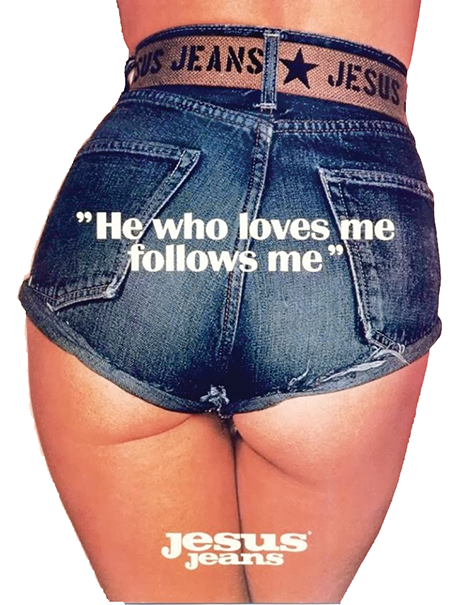Jesus is a Brand of Jeans

JEAN KILBOURNE is the author of Can’t Buy My Love: How Advertising Changes the Way We Think and Feel and So Sexy So Soon: The New Sexualized Childhood and What Parents Can Do to Protect Their Kids. The creator of the award-winning film series, Killing Us Softly: Advertising’s Image of Women, she was recently inducted into the National Women’s Hall of Fame. On May 9, Kilbourne accepted the 2015 Humanist Heroine award from the Feminist Caucus of the American Humanist Association at the AHA’s annual conference in Denver, Colorado.
AN AD FOR THULE car rack systems features a small child in the backseat of a car, protected only by a seatbelt. Next to the child, assorted sporting gear is carefully strapped into a carseat. The headline reads: “We Know What Matters to You.” In case one misses the point, further copy adds, “Your gear is a priority.”
Another ad features an attractive young couple in bed. The man is on top of the woman, presumably making love to her. However, her face is completely covered by a magazine, open to a double-page photo of a car. The man is gazing passionately at the car. The copy reads: “The ultimate attraction.”
 These ads are meant to be funny, of course. Taken individually, I suppose they might seem amusing or, at worst, tasteless. As someone who has studied ads for a long time, however, I see them as part of a pattern—just two of many ads that state or imply that products are more important than people. Ads have long promised us a better relationship via a product: buy this and you will be loved. But more recently they have gone beyond that proposition to promise us a relationship with the product itself: buy this and it will love you. The product is not so much the means to an end, as the end itself.
These ads are meant to be funny, of course. Taken individually, I suppose they might seem amusing or, at worst, tasteless. As someone who has studied ads for a long time, however, I see them as part of a pattern—just two of many ads that state or imply that products are more important than people. Ads have long promised us a better relationship via a product: buy this and you will be loved. But more recently they have gone beyond that proposition to promise us a relationship with the product itself: buy this and it will love you. The product is not so much the means to an end, as the end itself.
After all, it is easier and considerably safer to love a product than a person. Relationships with human beings are messy, unpredictable, and sometimes dangerous. “When was the last time you felt this comfortable in a relationship?” asks an ad for shoes. Our shoes never ask us to wash the dishes or tell us we’re getting fat. Even more important, products don’t betray or abandon us. “You can love it without getting your heart broken,” proclaims a car ad. One certainly can’t say that about loving a human being, as love without vulnerability is impossible.
We are surrounded by hundreds, thousands, of messages every day that link our deepest emotions to products, that objectify people and trivialize our most heartfelt moments and relationships. Every emotion is used to sell us something. Our wish to protect our children is leveraged to make us buy an expensive car. A long marriage simply provides the occasion for a diamond necklace. A painful reunion between a father and his estranged daughter is drawn out and dramatized to sell us a phone system. Everything in the world—nature, animals, people—is just so much stuff to be consumed or to be used to sell us something.
The problem with advertising isn’t that it creates artificial longings and needs, but that it exploits our very real and human desires. Advertising promotes a corrupt and bankrupt concept of relationship. Most of us yearn for intimate and committed relationships that will last. We aren’t stupid: we know that buying a certain brand of cereal won’t bring us one inch closer to that goal. But we’re surrounded by advertising that yokes our needs with products and promises us that things will deliver what in fact they never can. In the world of advertising, lovers are things and things are lovers.
It may be that there is no other way to depict relationships when the ultimate goal is to sell products. But this apparently bottomless consumerism not only depletes the world’s resources, it also depletes our inner resources. It leads inevitably to narcissism and solipsism. It becomes difficult even to imagine a way of relating—to ourselves, our children, our partners, our environment—that isn’t objectifying and exploitive.
 Most people feel that advertising is not something to take seriously. Other aspects of the media are serious—the violent films, the trashy talk shows, the bowdlerization of the news. But not advertising! Although much more attention has been paid to the cultural impact of advertising in recent years than ever before, just about everyone still feels personally exempt from its influence, holding the misguided belief that advertisements don’t affect them, don’t shape their attitudes, don’t help define their dreams. What I hear more than anything else, as I lecture throughout the world, is, “I don’t pay attention to ads,” “I just tune them out,” and “they have no effect on me.” I hear this most often from people wearing clothes emblazoned with logos. In truth, we are all influenced. There is no way to tune out this much information, especially when it is carefully designed to break through the “tuning out” process. As advertising critic Sut Jhally put it: “To not be influenced by advertising would be to live outside of culture. No human being lives outside of culture.”
Most people feel that advertising is not something to take seriously. Other aspects of the media are serious—the violent films, the trashy talk shows, the bowdlerization of the news. But not advertising! Although much more attention has been paid to the cultural impact of advertising in recent years than ever before, just about everyone still feels personally exempt from its influence, holding the misguided belief that advertisements don’t affect them, don’t shape their attitudes, don’t help define their dreams. What I hear more than anything else, as I lecture throughout the world, is, “I don’t pay attention to ads,” “I just tune them out,” and “they have no effect on me.” I hear this most often from people wearing clothes emblazoned with logos. In truth, we are all influenced. There is no way to tune out this much information, especially when it is carefully designed to break through the “tuning out” process. As advertising critic Sut Jhally put it: “To not be influenced by advertising would be to live outside of culture. No human being lives outside of culture.”
Much of advertising’s power in fact resides in this belief that advertising does not affect us. As Joseph Goebbels said, “This is the secret of propaganda: Those who are to be persuaded by it should be completely immersed in the ideas of the propaganda, without ever noticing that they are being immersed in it.” Because we think advertising is trivial, we are less on guard, less critical, than we might otherwise be. While we’re laughing, sometimes sneering, the commercial does its work.
We know by now that advertising often turns people into objects. Women’s bodies—and men’s bodies too these days—are dismembered, packaged, and used to sell everything from chainsaws to chewing gum, champagne to shampoo. But many people don’t fully realize that there are terrible consequences when people become things. Self-image is deeply affected. Girls’ self esteem plummets as they reach adolescence partly because they cannot possibly escape the message that their bodies are objects, and imperfect objects at that. Boys learn that masculinity requires a kind of ruthlessness, even brutality.
Things become especially dangerous when the products are potentially addictive, because addicts do feel they are in a relationship with their substances. I once heard an alcoholic joke that Jack Daniels was her most constant lover. When I was a smoker, I felt that my cigarettes were my friends. Advertising reinforces these beliefs, so we are twice seduced—by the ads and by the substances themselves.
The addict is the ideal consumer. Ten percent of drinkers consume over sixty percent of all the alcohol sold. These aren’t the folks who are having an occasional glass of wine with dinner or a beer with their pizza. Most of them are alcoholics or people in desperate trouble—but they are also the alcohol industry’s very best customers. Advertisers spend enormous amounts of money on psychological research and understand addiction very well. They use this knowledge to target children (because if you hook them early, they are yours for life), to encourage all people to consume more (in spite of often dangerous consequences for all of us), and to create a climate of denial in which all kinds of addictions flourish. This they do with full intent, as we see so clearly in the “secret documents” of the tobacco industry that have been made public in recent years.

Photo © Petr Malyshev, Modified
The consumer culture encourages us not only to buy more but to seek our identity and our fulfillment through what we buy, to express our individuality through our “choices” of products. Advertising corrupts relationships and then offers us products, both as solace and as substitutes for the intimate human connection we all long for and need.
In the world of advertising, lovers grow cold, spouses grow old, children grow up and away—but possessions stay with us and never change. Seeking the outcomes of a healthy relationship through products cannot work. Sometimes it leads us into addiction. But at best the possessions can never deliver the promised goods. They can’t make us happy or loved or less alone or safe. If we believe they can, we are doomed to disappointment. No matter how much we love them, they will never love us back.
Some argue that advertising simply reflects societal values rather than affecting them. Far from being a passive mirror of society, however, advertising is a pervasive medium of influence and persuasion. Its influence is cumulative, often subtle, and primarily unconscious. A former editor-in-chief of Advertising Age, the leading advertising publication in North America, once claimed: “Only 8 percent of an ad’s message is received by the conscious mind. The rest is worked and re-worked deep within, in the recesses of the brain.”
Advertising performs much the same function in industrial society as myth did in ancient societies. It is both a creator and perpetuator of the dominant values of the culture, the social norms by which most people govern their behavior. At the very least, advertising helps to create a climate in which certain values flourish and others are not reflected at all.
 Advertising operates not only in our physical environment, but increasingly in our spiritual environment as well. By definition, however, it is only interested in materialistic values. When spirituality shows up in ads, it is only in order to sell us something. Eternity is a perfume by Calvin Klein. Infiniti is an automobile, and Hydra Zen is a moisturizer. Jesus is a brand of jeans.
Advertising operates not only in our physical environment, but increasingly in our spiritual environment as well. By definition, however, it is only interested in materialistic values. When spirituality shows up in ads, it is only in order to sell us something. Eternity is a perfume by Calvin Klein. Infiniti is an automobile, and Hydra Zen is a moisturizer. Jesus is a brand of jeans.
Sometimes the allusion is more subtle, as in the countless alcohol ads featuring the bottle surrounded by a halo of light. Indeed products such as jewelry shining in a store window are often displayed as if they were sacred objects. Advertising co-opts our sacred symbols in order to evoke an immediate emotional response. Media critic Neil Postman referred to this as “cultural rape.”
It is commonplace to observe that consumerism has become the religion of our time (with advertising its holy text), but the criticism usually stops short of what is at the heart of the comparison. Both advertising and religion share a belief in transformation but most religions believe that this requires sacrifice. In the world of advertising, enlightenment is achieved instantly by purchasing material goods. An ad for a watch says, “It’s not your handbag. It’s not your neighborhood. It’s not your boyfriend. It’s your watch that tells most about who you are.” Of course, this cheapens authentic human identity and action. It’s junk food for the soul that leaves us hungry, empty, and malnourished.
Human beings used to be influenced primarily by the stories of our particular tribe or community, not by stories that are mass-produced and market-driven. As George Gerbner, one of the world’s most respected researchers on the influence of the media, said: “For the first time in human history, most of the stories about people, life, and values are told not by parents, schools, churches, or others in the community who have something to tell, but by a group of distant conglomerates that have something to sell.”
Although it is virtually impossible to measure the influence of advertising on a culture, we can learn something by looking at cultures only recently exposed to it. In 1980, for example, the Gwich’in tribe of Alaska got television for the first time, and with it massive advertising. Satellite dishes, video games and VCRs were not far behind. Before this, the Gwich’in lived much the way their ancestors had for generations. Within ten years, the young members of the tribe were so drawn by television they no longer had time to learn ancient hunting methods, their parents’ language, or their oral history. Legends told around campfires could not compete with Beverly Hills 90210. Beaded moccasins gave way to Nike sneakers, and “tundra tea” to Folger’s instant coffee.
As multinational chains replace local character, we end up in a world in which everyone is Under Armoured and Starbucked. Shopping malls kill vibrant downtown centers locally and create a universe of uniformity. We end up in a world ruled by, in John Maynard Keynes’s phrase, the values of the casino. On this deeper level, rampant commercialism undermines our physical and psychological health, our environment and our civic life, and creates a toxic society.
Advertising creates a worldview that is based on cynicism, dissatisfaction, and craving. Advertisers aren’t evil; they’re just doing their job, which is to sell a product. But the consequences, usually unintended, are often destructive. In the history of the world there has never been a propaganda effort to match that of advertising in the past fifty years. More thought, more effort, more money goes into advertising than has gone into any other campaign to change social consciousness. The story that advertising tells is that the way to be happy, to find satisfaction—and the path to political freedom, as well—is through the consumption of material objects. And the major motivating force for social change throughout the world today is this belief that happiness comes from the market.
An earlier version of this article was first published in the New Internationalist in September 2006 (Issue 393).
